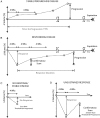Impact of imaging measurements on response assessment in glioblastoma clinical trials
- PMID: 25313236
- PMCID: PMC4195531
- DOI: 10.1093/neuonc/nou286
Impact of imaging measurements on response assessment in glioblastoma clinical trials
Abstract
We provide historical and scientific guidance on imaging response assessment for incorporation into clinical trials to stimulate effective and expedited drug development for recurrent glioblastoma by addressing 3 fundamental questions: (i) What is the current validation status of imaging response assessment, and when are we confident assessing response using today's technology? (ii) What imaging technology and/or response assessment paradigms can be validated and implemented soon, and how will these technologies provide benefit? (iii) Which imaging technologies need extensive testing, and how can they be prospectively validated? Assessment of T1 +/- contrast, T2/FLAIR, diffusion, and perfusion-imaging sequences are routine and provide important insight into underlying tumor activity. Nonetheless, utility of these data within and across patients, as well as across institutions, are limited by challenges in quantifying measurements accurately and lack of consistent and standardized image acquisition parameters. Currently, there exists a critical need to generate guidelines optimizing and standardizing MRI sequences for neuro-oncology patients. Additionally, more accurate differentiation of confounding factors (pseudoprogression or pseudoresponse) may be valuable. Although promising, diffusion MRI, perfusion MRI, MR spectroscopy, and amino acid PET require extensive standardization and validation. Finally, additional techniques to enhance response assessment, such as digital T1 subtraction maps, warrant further investigation.
Keywords: MRI; clinical trials; glioblastoma; imaging; response assessment.
© The Author(s) 2014. Published by Oxford University Press on behalf of the Society for Neuro-Oncology. All rights reserved. For permissions, please e-mail: journals.permissions@oup.com.
Figures





